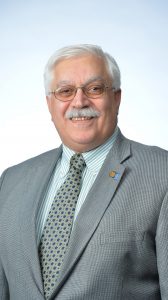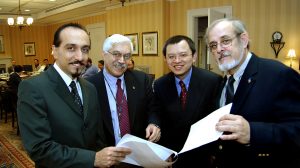
Mustafa Altinakar is the second director of the National Center for Computational Hydroscience and Engineering. Photo by Robert Jordan/Ole Miss Communications
The University of Mississippi’s National Center for Computational Hydroscience and Engineering already was renowned for its expertise in modeling water flow, sediment transport and erosion when Mustafa Altinakar became its director in 2010. But instead of being content with that reputation, Altinakar has pushed the center’s scientists and programs to even greater heights each year.
Altinakar joined the NCCHE in 2002 as a research professor and was promoted to director after Sam Shu-Yi Wang, the center’s founder-director and F.A.P. Barnard Distinguished Professor Emeritus of Mechanical Engineering, retired.
“Our center has a wide range of research interests, which encompasses free surface flows and hydrodynamics in rivers and coastal areas, soil erosion, sediment transport and morphodynamics changes, contaminant transport and fate, and water quality,” he said.
“A couple of years ago, we also constructed two experimental facilities at the laboratories of NSL (National Sedimentation Laboratory). One is a general-purpose dam-break and flood-simulation facility, which is currently being used for research in dam-break flows of granular materials.
“The other is a wave flume in which we have been studying wave attenuation by vegetation and bank erosion in agricultural ponds due to waves. The physical data collected have been invaluable for improving and validating our situational models. During the last two years, our researchers also designed field studies of boat-wave erosion in rivers.”
Altinakar also works to strengthen the center’s ties with federal and state agencies and private engineering companies to provide technology transfer and expertise. In addition, he oversees UM’s graduate program (M.S. and Ph.D.) in computational hydroscience and engineering, which is unique among SEC universities, and teaches various graduate courses.
“In recent years, the numerical modeling has gained wider acceptance and use in water resources management, conservation of water and land resources, environmental protection, prediction and prevention of water-related disasters due to its cost effectiveness in funds and time,” he said.
“We are very proud to be educating the next generation workforce that will carry on the future developments in computational hydroscience and engineering. An important part of my job is also to make sure that our research team, staff and students enjoy a stable, harmonious and friendly environment conducive to creative research and development work.”
Altinakar said he has found Ole Miss to be a tight-knit, encouraging community.

Mustafa Altinakar (second from left) discusses disaster and emergency management data with Nezih Altay, Haibo Wang and Dave Benway. Photo by Robert Jordan/University Communications
“NCCHE researchers, staff and students enjoy the small family atmosphere that stimulates open discussion and close collaboration,” he said. “I also enjoy the close collaboration we have with the School of Engineering and the UM Office of Research, who have been very supportive and attentive to our problems, which encourages us to work harder for achieving higher level of success.
“I particularly enjoy the close relationship and multidisciplinary collaborative research we have with several faculty and researchers in other departments in the School of Engineering and in the University of Mississippi as a whole.”
Before December 2002, Altinakar worked in Switzerland as the acting director of the Environmental Hydraulics Laboratory (formerly Hydraulic Research Laboratory) at the Federal Institute of Technology Lausanne (Ecole Polytechnique Fédérale de Lausanne). His decision to leave that post and become a research professor at NCCHE was motivated by his belief that he could help raise the center’s success to a higher level.
“I had first met Dr. Wang at the International Association for Hydro-Environment (Engineering and Research) conference in Tokyo, Japan, in 1993,” Altinakar said. “In 2000, he invited professor Walter Graf, my Ph.D. thesis supervisor, and myself to teach a short course in fluvial hydraulics here at NCCHE. At the end of the short course, he asked me to join NCCHE as a research professor and a potential candidate for the directorship at his retirement.”
Altinakar’s proven track record and visionary leadership are what prompted the offer, Wang said.
“Dr. Altinakar has tremendous ability to handle all kinds of things required to effectively hold his position,” Wang said. “Not only that, he is very personable, a great conversationalist who is able to make friends at almost first meeting.
“He is the perfect person for persuading people to adopt the computational modeling technology. The university was very fortunate he decided to accept the position here.”
Upon his return to Lausanne, Altinakar kept in touch with Wang, and they discussed how the former might contribute to the future of NCCHE. During his visit at Ole Miss, Altinakar had met his future colleagues and established a strong affinity due to their common research interests.
“What finally attracted me to NCCHE was not only the opportunity to work with a strong team of researchers at the forefront (of) numerical modeling technology, but also the fact that the modeling technologies were being transferred to federal and state agencies to solve real-life scientific and engineering problems,” he said.
“Organic research ties with the National Sedimentation Laboratory, Agricultural Research Service, U.S. Department of Agriculture, and the interaction with the U.S. Army Corps of Engineers’ Engineer Research and Development Center in Vicksburg were also important factors in making the decision to come to NCCHE. I felt that the research triangle formed by NCCHE, NSL and ERDC could be a good basis for pushing the frontiers of the state-of-the-art numerical modeling and making it available in scientific and engineering practice.”
After eight years as a research professor, Altinakar became NCCHE director in July 2010, following Wang’s retirement. In this role, he is responsible for bringing in funded research projects to sustain NCCHE as a leading research center in computational hydroscience and engineering. Since its establishment in 1983, NCCHE has succeeded in remaining a self-sustaining unit through funded research projects.
Altinakar is particularly proud of NCCHE’s research, which led to the development of dam and levee-break flood modeling and mapping software DSS-WISE™. This ongoing research was funded originally by the Science and Technology Division of the U.S. Department of Homeland Security through the Southeast Region Research program.
In 2012, NCCHE developed a web-based version of this software, called DSS-WISE™ Lite, which was provided free to all dam-safety stakeholders through a portal at Argonne National Laboratory. Until the end of 2014, this system handled more than 3,000 simulations of about 900 dams launched by more than 100 users from 41 states.
“In 2015, following the closing of the portal at ANL, many states expressed strongly the need for the continuation of DSS-WISE™ Lite service,” Altinakar said. “The U.S. Federal Emergency Management Agency signed a five-year ‘sole-source’ contract with NCCHE to develop a stand-alone web portal with DSS-WISE™ Lite capability. This was the first contract FEMA signed with the University of Mississippi. The fact that it is sole source goes to show that FEMA recognizes NCCHE as the only research group that can provide this capability.
“Our small team developed the stand-alone portal for the DSS-WISE™ Lite capability from scratch in less than a year, and FEMA has evaluated our work as ‘exceptional.’ In doing so, our team used primarily open-source technologies to create the web portal and trained several graduate students who are now employed by our center. Our team has now working expertise in this area, which is unique in our university and quite rare even across the other academic institutions in the U.S.”
In the second year of the five-year project, the DSS-WISE™ Lite server at NCCHE is providing web-based, automated dam-break capability to FEMA’s main office, 10 FEMA regional offices, the National Weather Service of the U.S. National Oceanic and Atmospheric Administration, the National Resources Conservation Service of the U.S. Department of Agriculture and all state dam safety offices, Altinakar said.
“I dare say that this is a unique capability in the world, which offers automated input data preparation, in addition to an extremely powerful and fast computational engine,” he said. “I am also proud to have introduced the development of GIS and numerical modeling-based decision support tools in inundation mapping and consequence analysis for flood risk analysis, general purpose Graphics Processing Unit, faster than real-time flood modeling.
“We have been closely working with the researchers at NSL to develop a web-based platform called AIMS (Agricultural Integrated Management System) that allows users to simulate any watershed in the conterminous U.S. This system is currently being tested and will soon be available free of charge to conservation engineers, watershed managers and scientists.”
Altinakar and his spouse, Ayse, have lived in Oxford for the past 15 years. She holds a degree in French philology from University of Lausanne in Switzerland. She is also a graduate of UM’s Patterson School of Accountancy. The couple has a son who earned a doctorate in mathematics from the Polytechnique Montréal, and lives and works in Montreal.
“I and Ayse are both book lovers,” Altinakar said. “We have a large library at home containing books in Turkish, French and English. I am an avid reader. I read novels, mystery books, history books, scientific books, etc. One of my favorite leisure activities is playing guitar (mostly classical and flamenco). I also draw and paint.
“I used to be a good tennis and table tennis player, but I cannot find time anymore.”